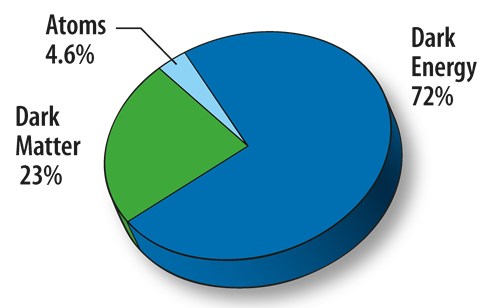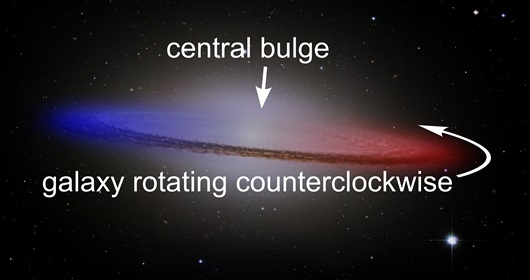Dark Matter
“Whenever you hear the word ‘dark’ in physics, you should get very suspicious, because it probably means we don’t know what we’re talking about.” – Harry CliffThis quotation is from Dr. Cliff’s excellent TED lecture, “Have we reached the end of physics?” For the record, Cliff does know what he’s talking about. He has worked on the LHCb experiment at CERN’s Large Hadron Collider, and he was awarded a joint fellowship between the Cavendish Lab at the University of Cambridge and the Science Museum in London.

This pie chart shows the relative proportions (by mass) of ordinary matter, dark matter, and dark energy in the universe, according to a recent estimate by NASA’s WMAP Team. The WMAP data is only accurate to two digits, so the total is not 100%.
Black holes are strange indeed, but they are not the most mysterious things that inhabit the cosmos. Over the past several decades, astronomers and cosmologists have come to the startling realization that visible objects like stars, planets, and nebulae account for only a small fraction of the mass of a galaxy, and galaxies account for only a fraction of the mass of the universe. Most of the mass in a galaxy consists of unidentified stuff called dark matter, and most of the mass of the universe as a whole comes from an unknown force (dark energy, which will be introduced on the next page). Like black holes, these mysterious entities have not been observed directly; they manifest their presence by influencing the motions of stars and other visible objects.
Compelling evidence for the existence of dark matter first came from observing how a spiral galaxy rotates. Astronomers expected that the motion of stars in a galaxy would be analogous to the motion of planets in our solar system: the farther an object is from the center, the slower its orbit. For example, Mercury whizzes around the sun at an average speed of 47 km/s, while Neptune crawls along at the comparatively sluggish pace of only 5.4 km/s. Similarly, stars near the middle of a galaxy should move faster than stars near the outermost perimeter. At least, that’s what we would expect, given that most of the visible things in a galaxy (stars, nebulae, etc.) are concentrated in the bulge—the dense, bright region of stars and gas at the galaxy’s center. If most of a galaxy’s mass is in the central bulge, then stars just outside the bulge should orbit the bulge rapidly, while stars farther from the bulge should orbit more slowly. Surprisingly, however, stars near the outermost perimeter of a spiral galaxy move about the same speed as stars near the central bulge!

with redshift and blueshift
If most of a galaxy’s mass is in its central bulge, then stars near the bulge should orbit faster than stars farther away. To test this hypothesis, astronomers measured the Doppler shift of starlight from nearby spiral galaxies that are oriented edgewise from Earth’s perspective. As the galaxy rotates, stars on one side are moving away from us, so their light is redshifted. Stars on the other side are moving toward us, and their light is blueshifted. (In this image, redshift and blueshift have been artificially exaggerated. The actual amount of Doppler shift is too subtle to detect with the human eye, but sensitive spectrometers can measure it.) By measuring the redshift or blueshift of stars at any given distance from a galaxy’s center, astronomers can determine the speeds of their orbits.
How is that possible? The simplest explanation is that most of a galaxy’s mass is not in its central bulge. Although the visible mass is concentrated mostly in the bulge, galaxies are surrounded by a lot of extra mass that we can’t see. To account for the orbits of stars in a typical spiral galaxy, the extra mass must fill and surround the whole galaxy in a roughly spherical “halo.” A swarm of dark objects or invisible particles, with randomly-oriented orbits, would do the trick. These hypothesized objects or particles are called “dark matter” because we cannot see them.
So, what is dark matter made of? That question remains unanswered, but numerous hypotheses have been proposed. One of the earliest ideas was that dark matter consists of massive compact halo objects (MACHOs). According to this hypothesis, galaxies are surrounded by a “halo” of massive objects that emit little or no light. These objects might include black holes, neutron stars, brown dwarf stars, asteroids, etc. Various kinds of massive, compact objects like those do exist throughout our own galaxy, and presumably they exist in other galaxies too. However, recent observations indicate that there aren’t nearly enough MACHOs to explain the orbits of stars in a galaxy. Unless we have wildly underestimated the number of MACHOs, therefore, dark matter must be made of something else.
A more popular hypothesis suggests that dark matter consists of undiscovered, microscopic particles. These particles must have mass, in order to influence the motions of stars with their gravity, but they don’t interact with ordinary matter or with light. Since they have mass and interact with matter only through the weak influence of gravity, these hypothetical particles are called weakly interacting massive particles (WIMPs). According to the WIMP hypothesis, each galaxy is filled and surrounded by these unknown particles, which vastly outnumber the particles of ordinary matter. Trillions of WIMPs might be flowing through us right now, but we can’t see them or feel them.
Unfortunately, no particles in the Standard Model of particle physics have the properties that WIMPs must have in order to play the role of dark matter. A speculative extension to the Standard Model—in particular, a theory called supersymmetry—does include particles that could act as WIMPs. So far, however, physicists have been unable to find direct evidence for supersymmetry or the particles it postulates.
Other possible candidates for dark matter have also been proposed. Most are similar to the WIMP hypothesis: they involve undiscovered particles that interact with ordinary matter through gravity.Examples include axions, sterile neutrinos, and GIMPs. All of these hypotheses are speculative, however. For now, the identity of dark matter remains a mystery.
Although we don’t know what dark matter is made of, the evidence for its existence is strong. In addition to measurements of galaxy rotation, further observations have confirmed that galaxies contain more dark matter than visible matter. For example, the phenomenon of gravitational lensing provides a way to measure the total mass of a galaxy, and galaxies measured in this way have significantly more mass than the visible matter they contain.
The most successful models of dark matter involve particles that are “cold” in the sense that their average speed is slow compared to the speed of light. As mentioned previously, the leading theoretical model of cosmology is the ΛCDM model, and the letters “CDM” stand for “Cold Dark Matter.” The Greek letter “Λ” (lambda) stands for the cosmological constant, a number that appears in the equations of Einstein’s general theory of relativity. The cosmological constant is associated with another mysterious entity, dark energy, which we will consider on the next page.